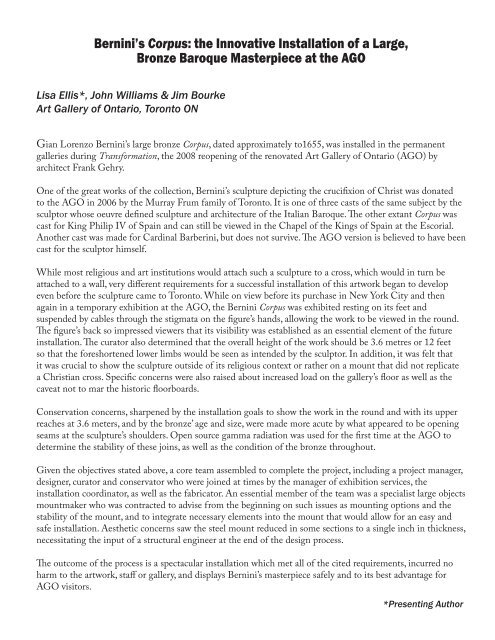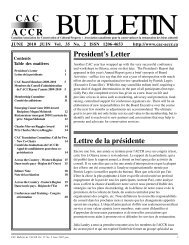Ottawa - Canadian Association for Conservation
Ottawa - Canadian Association for Conservation
Ottawa - Canadian Association for Conservation
Create successful ePaper yourself
Turn your PDF publications into a flip-book with our unique Google optimized e-Paper software.
Bernini’s Corpus: the Innovative Installation of a Large,<br />
Bronze Baroque Masterpiece at the AGO<br />
Lisa Ellis*, John Williams & Jim Bourke<br />
Art Gallery of Ontario, Toronto ON<br />
Gian Lorenzo Bernini’s large bronze Corpus, dated approximately to1655, was installed in the permanent<br />
galleries during Trans<strong>for</strong>mation, the 2008 reopening of the renovated Art Gallery of Ontario (AGO) by<br />
architect Frank Gehry.<br />
One of the great works of the collection, Bernini’s sculpture depicting the crucifixion of Christ was donated<br />
to the AGO in 2006 by the Murray Frum family of Toronto. It is one of three casts of the same subject by the<br />
sculptor whose oeuvre defined sculpture and architecture of the Italian Baroque. The other extant Corpus was<br />
cast <strong>for</strong> King Philip IV of Spain and can still be viewed in the Chapel of the Kings of Spain at the Escorial.<br />
Another cast was made <strong>for</strong> Cardinal Barberini, but does not survive. The AGO version is believed to have been<br />
cast <strong>for</strong> the sculptor himself.<br />
While most religious and art institutions would attach such a sculpture to a cross, which would in turn be<br />
attached to a wall, very different requirements <strong>for</strong> a successful installation of this artwork began to develop<br />
even be<strong>for</strong>e the sculpture came to Toronto. While on view be<strong>for</strong>e its purchase in New York City and then<br />
again in a temporary exhibition at the AGO, the Bernini Corpus was exhibited resting on its feet and<br />
suspended by cables through the stigmata on the figure’s hands, allowing the work to be viewed in the round.<br />
The figure’s back so impressed viewers that its visibility was established as an essential element of the future<br />
installation. The curator also determined that the overall height of the work should be 3.6 metres or 12 feet<br />
so that the <strong>for</strong>eshortened lower limbs would be seen as intended by the sculptor. In addition, it was felt that<br />
it was crucial to show the sculpture outside of its religious context or rather on a mount that did not replicate<br />
a Christian cross. Specific concerns were also raised about increased load on the gallery’s floor as well as the<br />
caveat not to mar the historic floorboards.<br />
<strong>Conservation</strong> concerns, sharpened by the installation goals to show the work in the round and with its upper<br />
reaches at 3.6 meters, and by the bronze’ age and size, were made more acute by what appeared to be opening<br />
seams at the sculpture’s shoulders. Open source gamma radiation was used <strong>for</strong> the first time at the AGO to<br />
determine the stability of these joins, as well as the condition of the bronze throughout.<br />
Given the objectives stated above, a core team assembled to complete the project, including a project manager,<br />
designer, curator and conservator who were joined at times by the manager of exhibition services, the<br />
installation coordinator, as well as the fabricator. An essential member of the team was a specialist large objects<br />
mountmaker who was contracted to advise from the beginning on such issues as mounting options and the<br />
stability of the mount, and to integrate necessary elements into the mount that would allow <strong>for</strong> an easy and<br />
safe installation. Aesthetic concerns saw the steel mount reduced in some sections to a single inch in thickness,<br />
necessitating the input of a structural engineer at the end of the design process.<br />
The outcome of the process is a spectacular installation which met all of the cited requirements, incurred no<br />
harm to the artwork, staff or gallery, and displays Bernini’s masterpiece safely and to its best advantage <strong>for</strong><br />
AGO visitors.<br />
*Presenting Author





